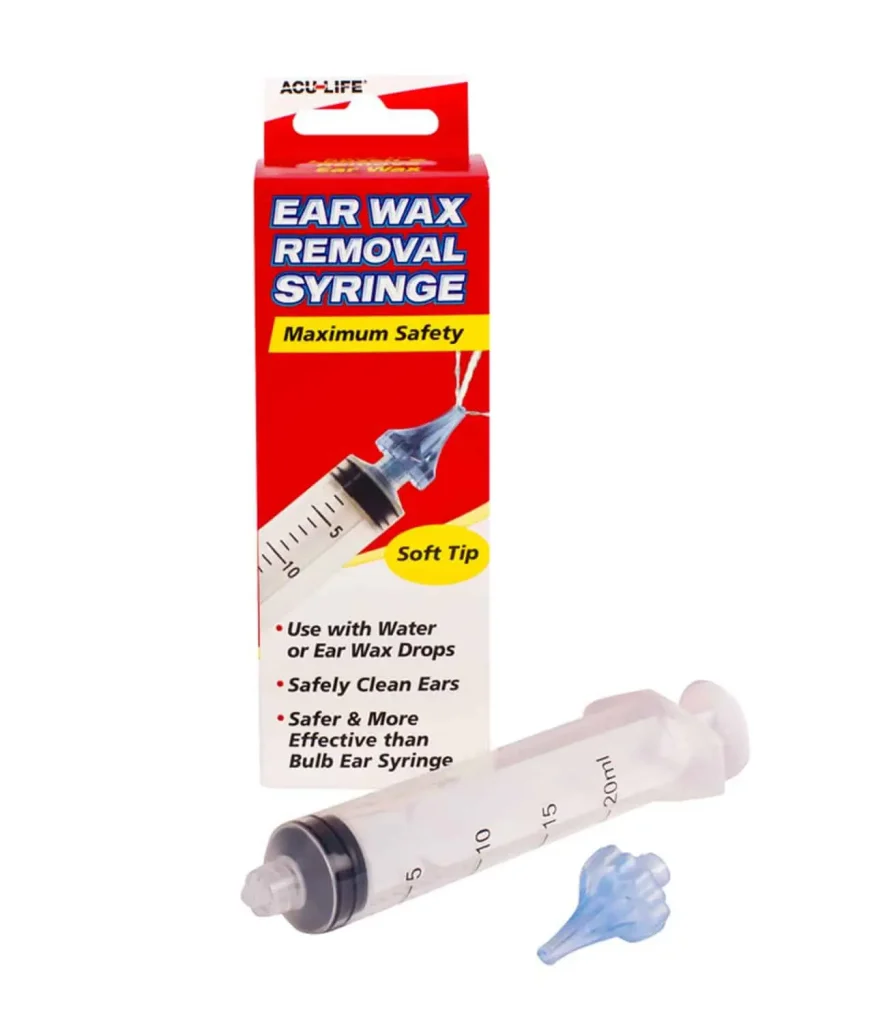WHAT IS IT?
Ear syringing is an outdated method of ear wax removal which has lost popularity over the years in favour of ear irrigation. It would normally only be considered if ear wax drops were not effective at removing ear wax. An old-fashioned metal syringe was historically used to pump water into the ear canal in an attempt to dislodge and flush out ear wax. These are rarely used today and substituted by lower pressured plastic ear syringes.
HOW IS IT PERFORMED?
Ear syringing is seldom performed by NHS GP’s or nurses anymore. Instead, ear syringing is usually self-administered by people using ear syringing kits available from over the counter in places such as Boots or over the internet. These ear syringing kits contain either a bulb-typed or flared-typed plastic ear syringe and are designed to squirt streams of water at different angles against the ear canal wall to avoid causing trauma to the eardrum. The idea behind ear syringing is for the water to get pumped ‘in behind’ the ear wax in order to flush it out of the ear.
The ear syringing procedure typically takes between 15-30 minutes to perform. This can vary depending on the amount and type of of ear wax, how deep the ear wax is inside the ear canal and whether you are having one or both ears treated. It is usually performed with the person sat still and their head slightly tilted so the affected ear is facing upwards. This is to help water travel down the ear canal as it is being squirted. As the water runs back out, a metal cup-shaped basin is placed beneath the ear to collect it and any ear wax it has flushed out.
THE BENEFITS
Ear syringing can be effective at removing ear wax if performed correctly and the ear wax is not fully impacted and blocking the ear. The home ear syringing kits are also relatively inexpensive. In addition, if self-administered ear syringing is successful at removing ear wax it avoids having to have the ear wax removed by some other treatment method. Some people can also find ear syringing therapeutic.
LIMITATIONS AND SIDE EFFECTS
Ear syringing must not be performed in people who have a perforated eardrum or grommet, mastoid cavity, cleft palate, foreign object inside the ear canal or have had an outer or middle-ear infection in the last 6 weeks. It is also not appropriate for ear syringing to be performed if you have a weak or healed eardrum following a perforation in the last 12 months or had any ear surgery within the last 18 months.
In addition, the ear wax must be prepared prior to ear syringing by softening it with ear drops such as olive oil for several days to a week (sometimes longer) beforehand. It is not uncommon during this period for the ear drops to cause the ear wax to expand and further increase the ear blockage and exacerbate any other associated symptoms. Occasionally, the ear drops can trigger ear infections and irritation. Also, no treatment of ear wax removal is completely ‘risk-free’. Some of the known ear syringing side effects and complications include:
- Ear wax being further impacted into the ear canal by the water being pumping into the ear.
- Damage and trauma to the ear canal and eardrum (including perforation).
- Hearing loss (temporary or permanent) and tinnitus (ringing type noise inside the ear) or worsening of it if already experienced. This is rare.
- Faintness, dizziness or vertigo if the water is not at body temperature. This is due to the ‘caloric’ effect and is normally only short lasting.
- An outer ear canal infection (e.g. otitis externa). This is more likely in people who have eczema or history of developing ear infections.
- Infection of the porous and air-filled bone surrounding the ear (mastoiditis).
- If self-administered, there is no clinical inspection of the outer ear and ear canal before or after the procedure to check for any contraindications and complications.



